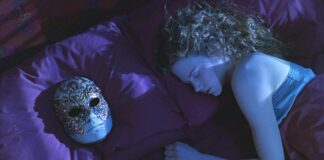Tsianina Redfeather Blackstone was born in 1882, of the Muscogee Creek Nation. Born to Creek and Cherokee parents, she was sponsored by Alice Robertson to study classical singing in Denver, Colorado.
A successful artist and activist in her own right, she partnered with composer and pianist Charles Wakefield Cadman to tour, giving recitals to predominantly white, American audiences. Cadman had visited reservations to study Native American music and instruments, and was a notable presence and supporter of the “Indianist movement” of the early 1900s. Together with Tsianina Redfeather, they brought Indian culture to white audiences, in an attempt to create a truly American musical style. The “Indianist movement” was in many ways a preservationist movement, and through their music, they hoped to draw attention to the Indigenous populations that, thanks to political, racial, and media bias, many believed were dying out.
The pair also collaborated with Nelle Richmond Eberhart on the libretto of the opera Shanewis (or The Robin Woman, 1918), which was based on her semi-autobiographical stories and contemporary issues for Native Americans.
This is the central theme of “I Call Myself Princess”, as the play revolves around the principal character, William Morin, a modern-day Métis music student, who is assigned to sing music from Shanewis. The young Morin begins to unravel and becomes obsessed with finding out the history of the work and his ancestry, while being faced with complex issues faced by Indigenous performers both of the past and present. During his spiral, he begins to interact with Tsianina Redfeather, and the play moves back and forth between the two time periods.
The script, written by Jane Lauzon, did an exceptional job of depicting the life of the fascinating Tsianina Redfeather, highlighting her success as an artist and activist. The play touched on important social issues that are still relevant today. Issues of cultural appropriation, racism, the difficult depiction of the sacred in performance, and the constant question of value and double-standards applied to non-white artists. These topics, amongst others, were approached with sensitivity and open-mindedness.
Lauzon’s writing included discussions, impact and different points of view, and was not presented as a polemic or a declamation of how the viewer should think. That being said, Lauzon used the dialogue between Tsianina Redfeather and William Morin to flesh out many of these issues, which was a good idea, but in performance the discussion felt a bit forced, and almost juvenile in their recitation. The key moments of discussion often fell flat as the characters had to spell out in extremely clear terms what the issues were and exactly how their characters were effected by them. This was a choice made by Lauzon, and if I were to guess, in discussion with skilled dramaturge Marjorie Chan, likely taking into account the audience and what they truly wanted to communicate. I felt that the play lost momentum in these moments, but can appreciate the choice to focus on conveying these issues in the most apparent way possible. This slowing of the pace could likely be adjusted with a slightly different direction and treatment of the relationship between the two characters.
The inclusion of mezzo-soprano Marion Newman as Tsianina Redfeather, performing her music live and accompanied by Richard Greenblatt as Charles Wakefield Cadman on the piano were the highlights of the show. Newman is a gifted singer who brings sensitivity to both her singing and acting, and does the repertoire great justice. Her portrayal of Tsianina Redfeather was engaging and showed a good depth of character. Though misinformed, she showed steadfastness of character, and didn’t slip into portraying her as naive or taken advantage of. Newman depicted Tsianina Redfeather as a product of her time, doing her best to live and work in a testing, racist, social climate. She showed intelligence in her interaction with Greenblatt, who was a solid counterpart and partner. His piano playing and acting showed skill, and provided a well-matched talent to Newman’s in the musical interludes.
Cadman’s librettist Nelle Eberhart, played by Courtney Ch’ng Lancaster, portrayed an exuberant scholar and writer, another product of her time, trying to bring cultured society to the height of modernity. Lancaster managed to do justice to Eberhart’s role as librettist, though she did highlight her ignorance, even through her self-described, good intentions. From our modern perspective these attempts by the two seem quaint and misinformed, but for their time, they were considered open-minded, inclusive and modern.
The part of the play that could use the most work is the modern day story of William Morin, played by Aaron Wells. I felt that the play revolved too much around his unravelling and personal issues, and could have benefitted from more development of the flashback moments in the play. The split in time felt awkward and I got very little from Wells’ depiction of Morin. His character was very self-centred and of little depth. There really wasn’t much for me to grab onto and he didn’t engage me as an audience member as I hoped he would. His role could benefit from further development and perhaps, a reworking in terms of story structure.
His stage-partner Alex Park, played by Howard Davis, was much more engaging, and stood out in his portrayal of both Park and other minor roles. Davis stole the scenes with his sensitive portrayal of Morin’s neglected partner, and anchored each scene he appeared in.
Altogether, I Call Myself Princess was a solid production that deserves further development and performance. I hope that I see this show remounted in the near future.
I Call Myself Princess
A Paper Canoe Projects and Cahoots Theatre Production in association with Native Earth Performing Arts.
Written by Jani Lauzon
Directed by: Marjorie Chan
Musical Direction & Composition by: Jerod Impichchaachaaha’ Tate
Featuring Courtney Ch’ng Lancaster, Howard Davis, Richard Greenblatt, Marion Newman, and Aaron M. Wells
September 9-30, 2018
Tues-Sat 8 PM
Sun 2 PM
Aki Studio
—

